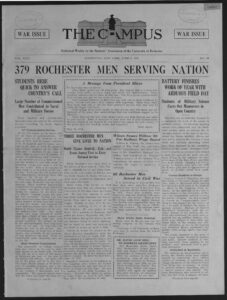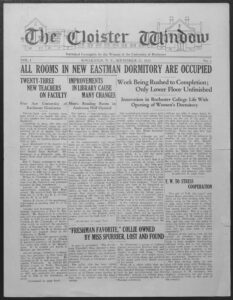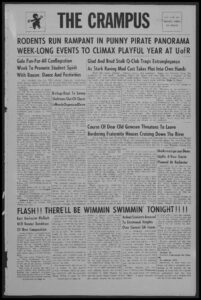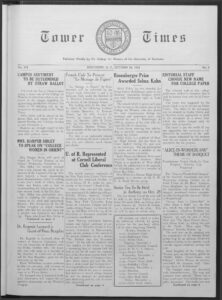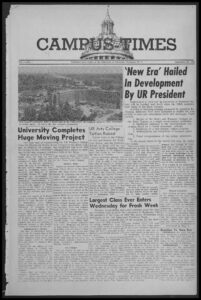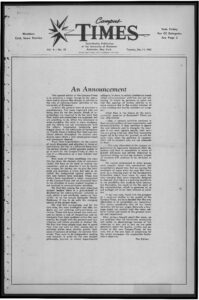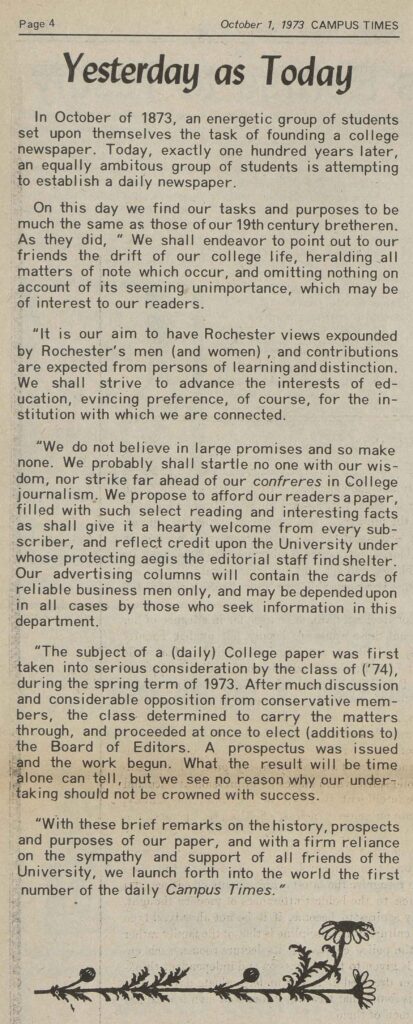The Campus Times at 150
The Campus Times at 150
Since starting as the University Record in 1873, the paper known affectionately as “CT” has never stopped informing, entertaining, opining, and offering its staff a training ground for journalism and life.
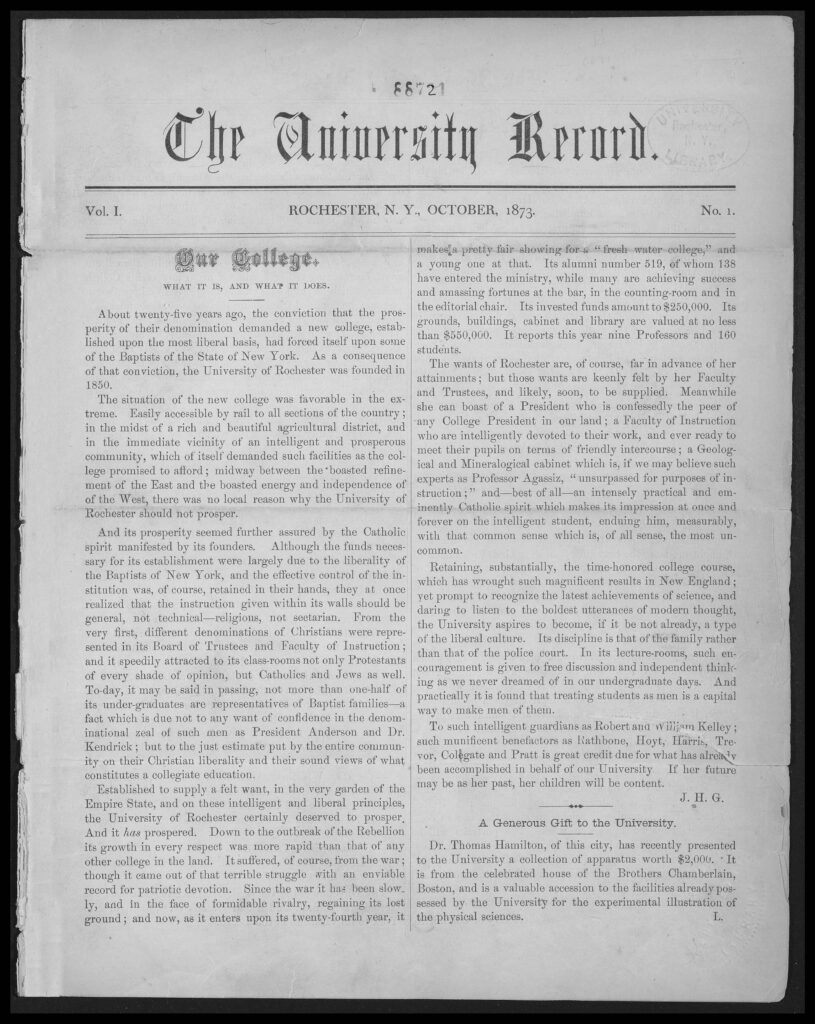
A NEW RECORD: What is now the Campus Times began its life in October 1873 as the University Record. The Record featured editorials, news on undergraduates and alumni, poems, jokes, and advertisements.
Alyssa Koh ’24 enjoys poring through old issues of the Campus Times, as well as its predecessors, dating back to 1873. She looks at digitized versions of the oldest papers on the University Archives website and flips through more recent bound copies in the paper’s office in Wilson Commons.
“It’s amazing to see how many different people have contributed to so many different stories over the years,” says the editor-in-chief of the paper students call “CT.” “I’m proud to be a small part of its history.”
This fall marks 150 years of almost continuous student reporting. From the inaugural issue of the University Record, launched as a monthly in October 1873, to the most recent CT, published weekly online, undergraduate journalists have informed and entertained the University community from a student perspective. In the process, they’ve trained themselves for distinguished care.
“The Campus Times has been a campus family for many students over the years,” says Anne-Marie Algier, interim dean of students and the paper’s longtime advisor. And because it places big demands on students’ time, “many have gone on to careers in journalism, law, and other fields where the CT laid the foundation for their work ethic.”
“Working on the Campus Times taught me a ton about reporting, writing, and editing, but it also taught me a lot about teamwork, time management, and accountability,” says Rachel Dickler Coker ’96, editor-in-chief in 1994. “It was not easy to make our weekly deadline as full-time students. I felt tremendous satisfaction when I saw a good piece in print under my name.”
A newspaper for students, by students
Twenty-three years after the University opened its doors, eight students established the University Record, the first campus newspaper at the then all-male institution located on Prince Street. The inaugural edition that rolled off hand-cranked presses in the fall of 1873 looked more like a magazine than a newspaper.
“The primary objective of this journal is to furnish friends and patrons of the University with reliable information concerning its workings and history,” the editors wrote. “We are confident that it will meet a want long felt by the students.”
The Record featured editorials, news on under-graduates and alumni, poems, jokes, and advertisements. It came with a subscription price: $1 for the year, equivalent to about $25 today.
We wanted to put out the best product we could, and sometimes it took all night. There were times when we’d disagree on what the lead story was, or the headline, but we knew we had a deadline and we figured out how to meet it. —Todd Pipitone ’01 (T5), Opinion Columnist
News from the home front
World War I affected the University deeply and directly, and the Campus provided news of enlistments, promotions, and casualties among members of the community. But the paper was also a cherished source of home front news for students like Alfred Veness, a member of the Class of 1920, who had joined Britain’s Royal Flying Corps in 1917. Veness was in basic training and nearing an assignment to France when he received a copy of the paper. An excerpt from his letter of gratitude was published on January 31, 1918:
I received the last edition of The Campus about a week ago and was very pleased indeed to have it and learn all about the activities in dear old Rochester. . . . It means a lot to have such news when one is away from the University.
A newspaper rivalry
Students in the College for Women—lacking representation in the men’s Campus—launched their own paper, the Cloister Window. Competition between the Campus and the new upstart was fierce. In the 1920s, the Campus published an article declaring that the women were not “welcome” on its Prince Street campus. Annette Gardner Munro, dean of women from 1910 to 1930, responded by canceling her subscription to the Campus and banning it from the women’s enclave on the other side of University Avenue.
In 1932, two years after the College for Men moved to the River Campus, the women, now with the Prince Street Campus to themselves, renamed their paper the Tower Times—a reference to its office location high up in Cutler Union.
MEDIA MANIA: Students at the College for Women created the Cloister Window, which became the Tower Times in 1932. Times staff and their male counterparts at the Campus enjoyed a friendly rivalry—to wit, the Tower Times’s publication of the Crampus on April 1, 1949.
There were many, many jokes and malapropisms that still hold to this day, that ended up semi-immortalized on the quote boards hung around the newsroom—and lots of squealy gobblers from the pit, backdoor pizzas, too much non-diet soda and other unhealthy foods, but always fantastic music playing in every corner of the newsroom.”—Allegra Boverman ’96, Photo Editor
Another World War—and a brief media merger
Another world war affected the University—and the Campus family—as profoundly as the first.
“Young men have no burning desire to act as receivers for machine-gun fire,” Campus editor Robert Zwierschke ’39 wrote in an editorial published on April 29, 1939. Three years later, Zwierschke became the first Rochester alumnus to die in the fighting when the aircraft carrier USS Lexington was torpedoed and sunk by the Japanese navy.
Amidst the tragedies of the war, there were some bright spots, notably for women on the home front. With so many young men called away to service, the Campus found it difficult to maintain a staff, and in March 1943 a “war marriage” took place with the Tower Times. For the remainder of that semester, the Tower Times and the Campus went on hiatus as staff joined to publish the Campus-Times.
The women weren’t just part of the team; they were the managers. Anne Houlihan Keefe ’46 told Rochester Review in 1988, “With the wartime short-age of men, we were involved and often led in every-thing: the plays, the yearbooks, and the newspapers. A whole generation of women bloomed with the chance to exercise authority.”
Keefe became a pioneer in Rochester radio and television and for years was the only woman broadcaster on Rochester TV. She moved in 1976 to KMOX-AM in St. Louis, where she was the first female interviewer. When she died in 2015 at the age of 90, St. Louis Public Radio declared that Keefe’s “smoky voice, inimitable style, and consuming dedication to work made her one of the most important figures in television and radio for more than 50 years.”


HARD TIMES: Its staff having dwindled to just a few juniors and seniors, CT ran a stark editorial at the close of the 1962 fall semester (right). “We find that increasingly, and for the first time, the most intelligent and able students are not entering extra-curricular activities,” the editors lamented.
The dry spell came a mere seven years following the merger of the Tower Times and the Campus to become the Campus-Times (left). The step coincided with the merger of the colleges into a single coeducational institution on the River Campus in 1955.
Introducing the Campus Times
Although students published five issues of the “Campus-Times” during the brief merger of 1943, the CT, as it’s known today, traces its birth to 1955. That was the year the women moved from Prince Street to join the men on the River Campus. Women continued to play a large role in campus journalism: the last editor of the Tower Times, Sally Miles ’56, became the first editor of the new Campus-Times.
Overriding my time at UR was the Vietnam War. It played a big part in the stories we wrote. We also focused attention on University governance and the conflicting roles of administration, faculty, and students. Of course, we also covered stories about other student activities . . . some people felt the paper devoted too much attention to these political issues and started a competing paper focused on more typical student activities. However, I don’t regret the choices we made for the Campus Times.”—Laura Drager ’70, Editor-in-Chief
Paper nearly folded
In December 1962, the very existence of the Campus Times (now sans hyphen) was tested when its staff had dwindled to just a few juniors and seniors. The editors published a two-page edition, with the front page a stark, two-column editorial titled “An Announcement.” The paper, published twice weekly, would be reduced from 12 pages to four. The editors decried the state of extracurricular activities on campus, attributing part of the lack of student interest to “the infusion of a few exciting new faculty members.”
A year later, the paper continued to struggle, according to Christian Yves Wyser-Pratte ’65, elected editor-in-chief in December 1963. “I inherited a dying rag,” he recalls. The paper, which received funds from student government, was back to eight pages but over budget, and the federal government had banned cigarette ads—which Wyser-Pratte says was the paper’s largest source of revenue—in college and university settings. He asked a Simon Business School professor to give him the name of the best business student, whom he could recruit as a business manager. Richard Hall ’66 took the role—a big part of a turnaround, Wyser-Pratte recalls. “I had a great team to work with,” he says, citing Hall, managing editors Cliff Fishman ’66 and Joyce Inglis ’65, and Marjorie (Mac) McDiarmid ’67, who became CT’s next editor-in-chief.
Telling it like it is
By the late 1960s, with war protests common across college campuses, many student newspapers were printing the speeches of visiting activists verbatim—obscenities included. The Campus Times was among them. Laura Drager ’70 was editor-in-chief when Black Panthers leader Eldridge Cleaver spoke at Strong Auditorium in 1968. The CT quoted him word for word, including language that offended some members of the local community.
“Most of the students heard Cleaver’s talk,” Drager told the Rochester Democrat and Chronicle. “They’d think we were misrepresenting the man if we didn’t use his words in the story.”
Some students felt the Campus Times devoted too much attention to the war and other controversial issues. Drager, who went on to a distinguished legal career, serving on the New York State Supreme Court, recalls the criticism. Some students “started a competing paper that focused on more typical student activities,” she says. “But I don’t regret the choices we made for the Campus Times.”
We were crazy! During my years, we put out a daily 8 12-page paper. I was the photo editor meaning shooting film, processing, drying, and printing the images each evening. It was always a bit frantic. Ray `{`MacConnell`}` was always a great help and a calm voice, and I met many great people taking their photo for the CT.” —Jonathan Trost ’82, Photo Editor
On-the-job training
In 1973, the Campus Times marked 100 years of student journalism at Rochester by becoming a daily. Staff often worked through the night several times a week. “My attendance in class became increasingly spotty,” Marc Rosenwasser ’74, editor-in-chief that year, told Review in 2013. “At one point, my father asked me what exactly he was paying for.”
Rosenwasser went on to serve as Moscow correspondent for the Associated Press and as a television producer the CBS Evening News, NBC’s Date-line, and PBS NewsHour Weekend.
Coker says being on staff presented “incredible opportunities” for student journalists. “I interviewed Elie Weisel and Kurt Vonnegut and had a standing weekly meeting with the University president,” adds Coker, who went on to a long career in journalism and is now director of research advancement at Binghamton University.
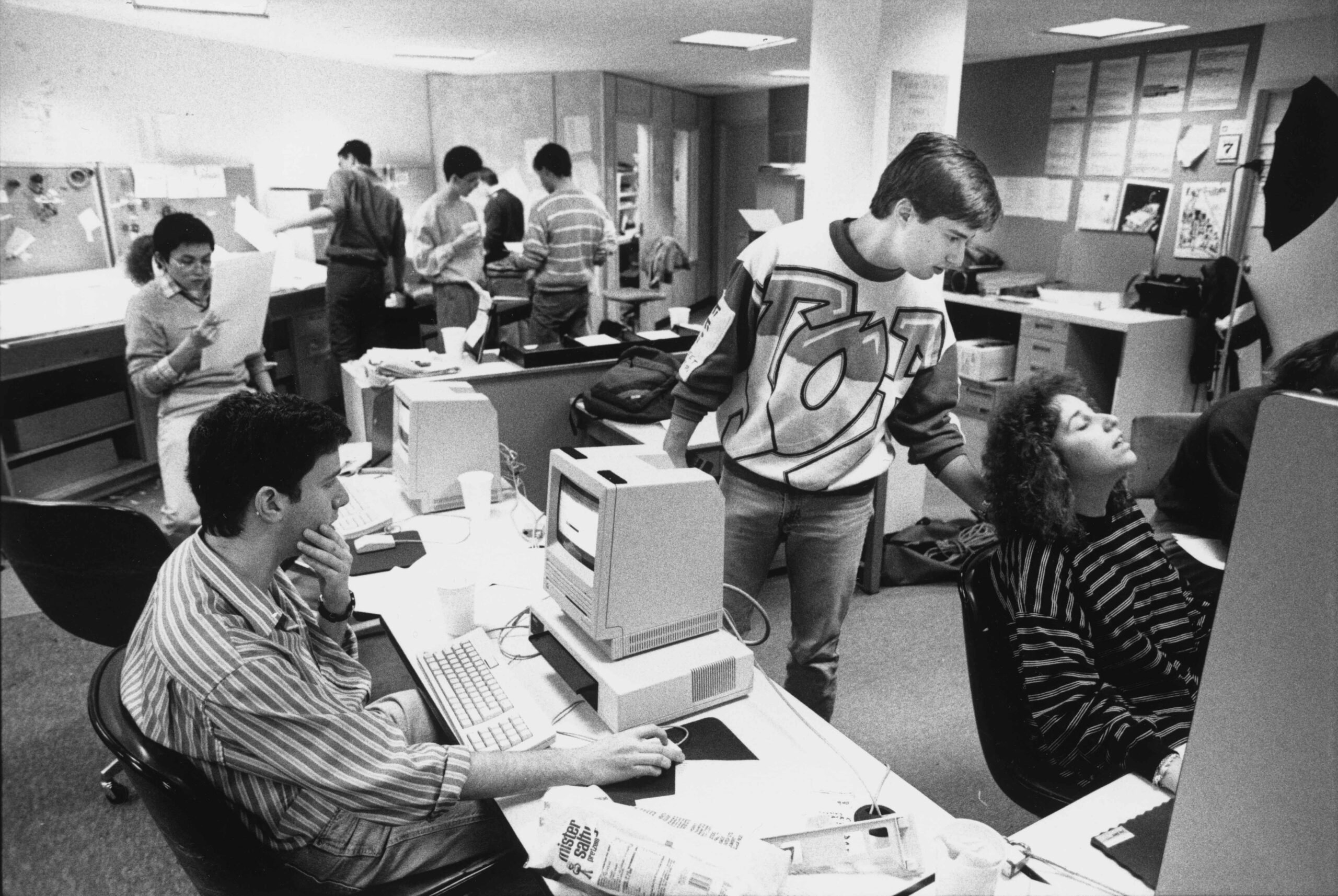
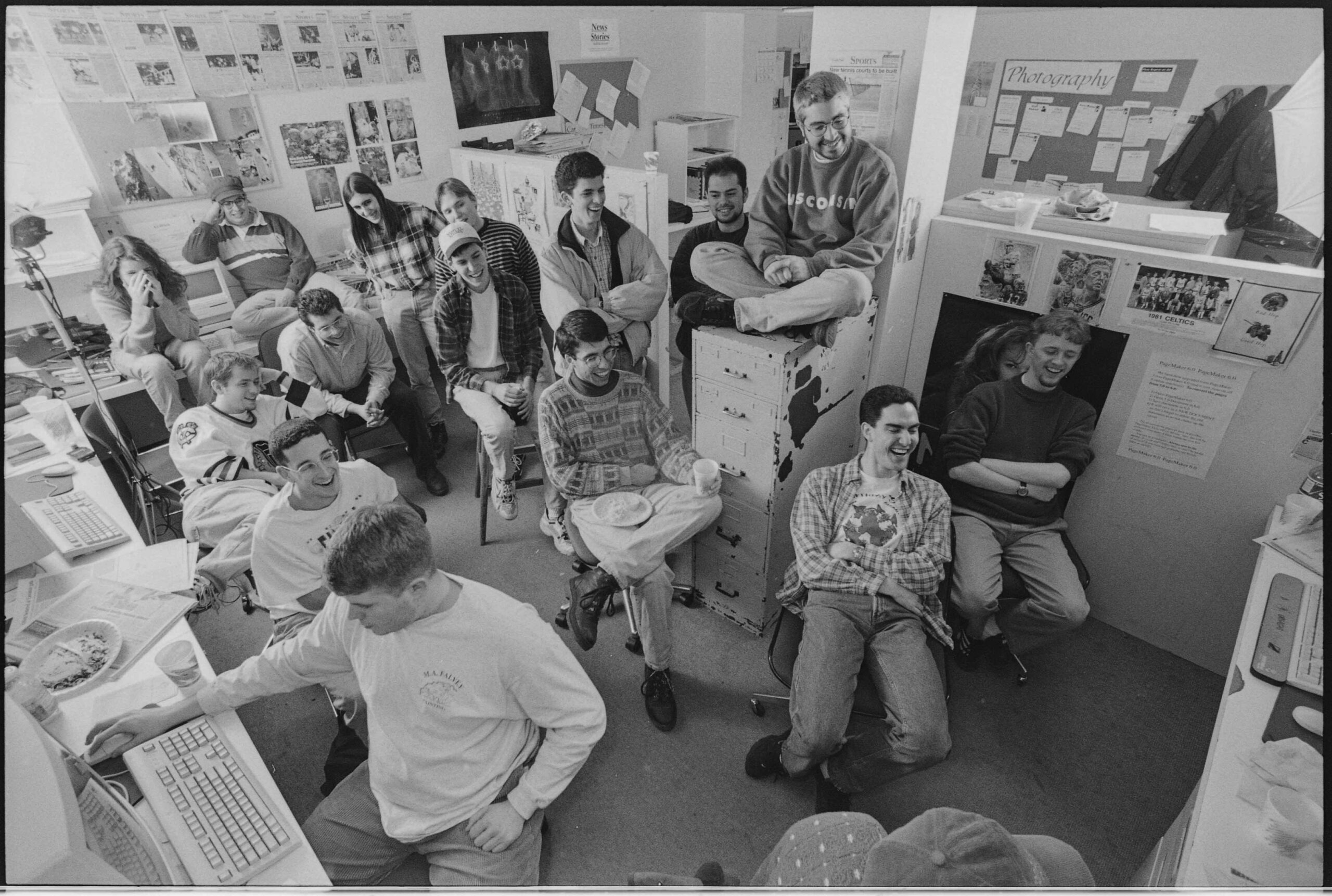
ROOM 102: “The Weekly Miracle of Room 102” is what Review called CT in 1988. Staff in that year (left), in 1997 (right), and in nearly every other year since the late 1970s have made the first floor of Wilson Commons a hive of activity.
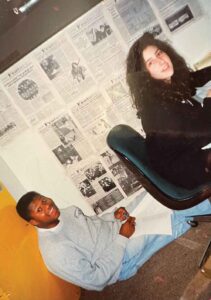
FEATURED: Managing editor Dwayne Samuels ’93 (left) and syndications editor Louise Aibel Litt ’94 pause during production to pose for photo editor Allegra Boverman ’96. CT pages were spread across the office walls to make them easy to refer to. Samuels and Litt occupied the “features section” of the office in this image from 1993.
CT’s “Honorary Uncle”
When the staff worked through the night to put out a Thursday morning paper, Ray MacConnell, the University’s graphic arts manager, supplied the staff with dozens of homemade chocolate chip cookies. And when someone from the suburban shop where the paper was printed failed to show on a Thursday, it was MacConnell who drove the pages to the printer.
“Ray was an incredibly special person,” Coker says of MacConnell, who worked at the University for 30 years and died in 2019. “He never had kids of his own, but he was an important friend and mentor to decades of Campus Times editors. He was an honorary uncle to all of us.”
CT today
In 2018 the Campus Times went mostly digital. A print paper—about 2,000 copies—is still published once a month. The staff of about 25 is headed by editor-in-chief Alyssa Koh ’24 and publisher Sarah Woodams ’24 (T5).
The Wilson Commons office is quieter than in eras past. Sundays are busy, with staffers com-ing in to edit stories, but editors also can work remotely on their own laptops. Much activity takes place on social media. Today’s Campus Times has a social media editor, Alice Guzi ’26, who manages CT accounts on Facebook, Instagram, and X (for-merly Twitter) along with Karis Kelly ’27 and Jane Oliver ’25.
Woodams, a double major in environmental studies and studio art, is thinking of working in social media. At the Campus Times, she says, “I’ve learned how to manage people and the importance of deadlines in the business world,” she says.
Koh, who is studying English and linguistics, is considering a career in journalism. And though she will leave the Campus Times when she graduates, Koh says the Campus Times will never leave her.
“A student newspaper is where people in the campus community can become aware of import-ant goings-on outside their standard scope, and that makes it crucial that it’s run by and for the students,” she says. “To get a view of the University that the University wants you to see, take a campus tour. To really understand what’s happening on campus—to me, that’s the point of the Campus Times.”
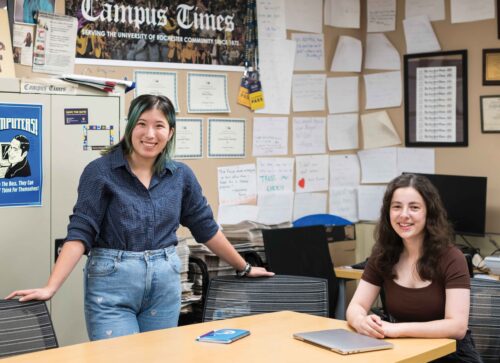
21ST-CENTURY EDITION: Editor-in-chief Koh and publisher Woodams lead a staff of about 25 that includes three members devoted to maintaining CT social media accounts. Student journalism, Koh says, helps students “really understand what’s happening on campus.”
150 Years of Change
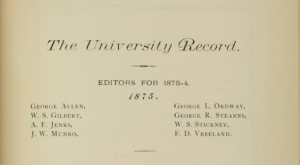
1873: Eight students establish the University Record, the first campus newspaper at Rochester. The paper is published monthly during the academic year.
1876: University Record becomes Rochester Campus and is published twice monthly.
1887: Rochester Campus is shortened to the Campus.
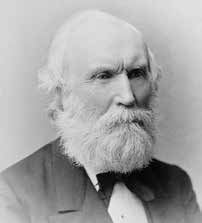
1890: The Campus publishes the first photo ever to appear in the paper, a portrait of President Martin Anderson.
1908: Campus becomes a weekly.
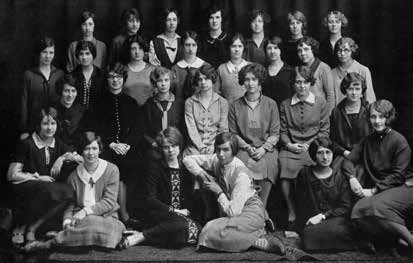
1925: Students in the College for Women—established in 1914 alongside the College for Men—launch their own paper, the Cloister Window.
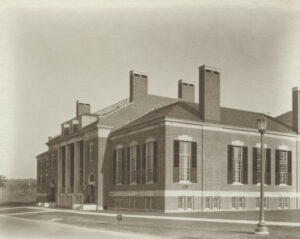
1930: The men move from Prince Street to the new River Campus. The Campus sets up shop in Todd Union.
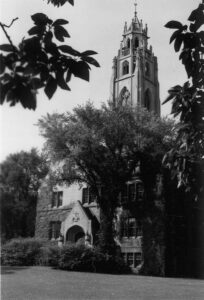
1932: The women, now with the Prince Street Campus to themselves, rename their paper the Tower Times.
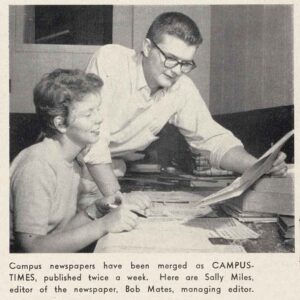
1955: The men’s and women’s colleges—as well as their newspapers—merge on the River Campus. The Campus and the Tower Times become the Campus-Times. Tower Times editor Sally Miles ’56 becomes the first editor of the Campus-Times. The hyphen is later dropped.
1973: Celebrating 100 years, the Campus Times announces in October that it will go from twice weekly to daily (Monday–Friday).
1976: The Campus Times office moves from Todd into the brand new student center, Wilson Commons.
1983: After nearly a decade as a daily, the Campus Times cuts back to three issues per week.
1986: With four Macintosh SE computers for writing articles and laying out the design, the Campus Times enters the computer age.
1994: The Campus Times is named a finalist for the Associated Collegiate Press’s Pacemaker Award.
2018: Now a weekly, the Campus Times goes mostly online at Campustimes.org. There remains one print issue per month.
Support the Campus Times
Join us in preserving a legacy of student journalism. Learn how you can make a lasting impact on student voices.
— Jim Mandelaro, Rochester Review, Fall 2023



